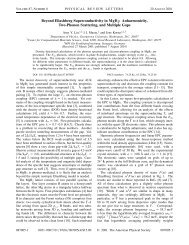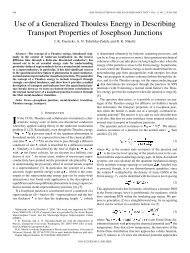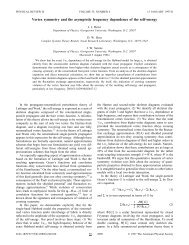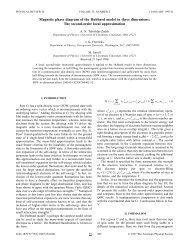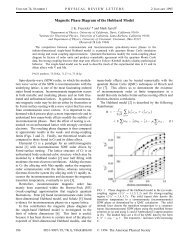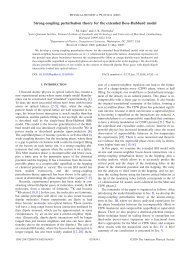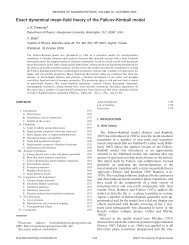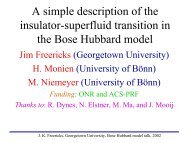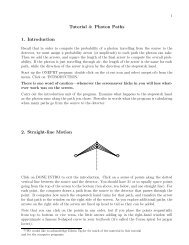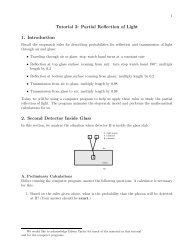Two dimensional melting far from equilibrium in a granular monolayer
Two dimensional melting far from equilibrium in a granular monolayer
Two dimensional melting far from equilibrium in a granular monolayer
Create successful ePaper yourself
Turn your PDF publications into a flip-book with our unique Google optimized e-Paper software.
PRL 95, 098002 (2005)<br />
PHYSICAL REVIEW LETTERS week end<strong>in</strong>g<br />
26 AUGUST 2005<br />
<strong>Two</strong>-Dimensional Melt<strong>in</strong>g Far <strong>from</strong> Equilibrium <strong>in</strong> a Granular Monolayer<br />
J. S. Olafsen 1, * and J. S. Urbach 2,†<br />
1 Department of Physics and Astronomy, The University of Kansas, Lawrence, Kansas 66045, USA<br />
2 Department of Physics, Georgetown University, Wash<strong>in</strong>gton, D.C. 20057, USA<br />
(Received 21 December 2004; published 26 August 2005)<br />
We report an experimental <strong>in</strong>vestigation of the transition <strong>from</strong> a hexagonally ordered solid phase to a<br />
disordered liquid <strong>in</strong> a <strong>monolayer</strong> of vibrated spheres. The transition occurs as the <strong>in</strong>tensity of the vibration<br />
amplitude is <strong>in</strong>creased. Measurements of the density of dislocations and the positional and orientational<br />
correlation functions show evidence for a dislocation-mediated cont<strong>in</strong>uous transition <strong>from</strong> a solid phase<br />
with long-range order to a liquid with only short-range order. The results show a strong similarity to<br />
simulations of <strong>melt<strong>in</strong>g</strong> of hard disks <strong>in</strong> <strong>equilibrium</strong>, despite the fact that the <strong>granular</strong> <strong>monolayer</strong> is <strong>far</strong> <strong>from</strong><br />
<strong>equilibrium</strong> due to the effects of <strong>in</strong>terparticle dissipation and the vibrational forc<strong>in</strong>g.<br />
DOI: 10.1103/PhysRevLett.95.098002<br />
The nature of the <strong>melt<strong>in</strong>g</strong> transition of a two<strong>dimensional</strong><br />
solid has been extensively studied s<strong>in</strong>ce the<br />
pioneer<strong>in</strong>g work of Kosterlitz and Thouless [1] and subsequent<br />
extensions by Halper<strong>in</strong>, Nelson, and Young [2,3],<br />
known collectively as the KTHNY theory. This cont<strong>in</strong>ues<br />
to be an active area of research [4,5], and <strong>in</strong>vestigations of<br />
colloidal particles suggest that the specific form of <strong>in</strong>terparticle<br />
<strong>in</strong>teractions can play a role <strong>in</strong> determ<strong>in</strong><strong>in</strong>g the<br />
nature of the <strong>melt<strong>in</strong>g</strong> transition [6]. The particular system<br />
of hard disks has been extensively studied by computer<br />
simulation, and there is considerable evidence that the<br />
<strong>melt<strong>in</strong>g</strong> transition is well described by the KTHNY scenario<br />
(see, e.g., [7,8] and references there<strong>in</strong>). That scenario<br />
describes two-<strong>dimensional</strong> <strong>melt<strong>in</strong>g</strong> as consist<strong>in</strong>g of two<br />
cont<strong>in</strong>uous transitions, the first <strong>from</strong> a crystall<strong>in</strong>e phase<br />
characterized by algebraically decay<strong>in</strong>g positional order<br />
and long-range orientational order to a hexatic phase characterized<br />
by short-range positional order and algebraically<br />
decay<strong>in</strong>g orientational order. The hexatic phase melts <strong>in</strong>to<br />
a liquid with only short-range order. Both transitions are<br />
mediated by topological defects; the first by unb<strong>in</strong>d<strong>in</strong>g of<br />
dislocation pairs, the second by unb<strong>in</strong>d<strong>in</strong>g of discl<strong>in</strong>ation<br />
pairs (see [9] for a review).<br />
S<strong>in</strong>gle layers of identical macroscopic spheres subjected<br />
to mechanical vibration undergo transitions that share, at<br />
least superficially, many of the characteristics of <strong>equilibrium</strong><br />
atomic and molecular <strong>melt<strong>in</strong>g</strong> transitions [10–13].<br />
The external vibration is necessary to keep the macroscopic<br />
spheres <strong>in</strong> motion because of the <strong>in</strong>evitable loss of<br />
energy to friction and <strong>in</strong>elastic collisions. As a result of the<br />
flow of energy <strong>in</strong>to the system <strong>from</strong> the external forc<strong>in</strong>g,<br />
and out of the system through dissipation, detailed balance<br />
is violated, and the results of <strong>equilibrium</strong> statistical mechanics<br />
are not generally applicable. We have shown directly<br />
that the fluctuat<strong>in</strong>g velocities of the <strong>in</strong>dividual<br />
spheres [13] and their correlations [14] differ significantly<br />
<strong>from</strong> those found <strong>in</strong> <strong>equilibrium</strong> systems. Thus, it may be<br />
expected that the dynamics of the <strong>melt<strong>in</strong>g</strong> transition observed<br />
for driven, <strong>in</strong>elastic spheres may be quite different<br />
<strong>from</strong> those observed <strong>in</strong> <strong>equilibrium</strong>. However, <strong>in</strong> at<br />
PACS numbers: 45.70.2n, 05.70.Fh, 05.70.Ln<br />
least one <strong>in</strong>stance, it has been shown that <strong>in</strong> certa<strong>in</strong> model<br />
systems the Gibbs distribution and detailed balance can be<br />
recovered by coarse gra<strong>in</strong><strong>in</strong>g over small length scales [15].<br />
In this Letter we report an <strong>in</strong>vestigation of the <strong>melt<strong>in</strong>g</strong><br />
transition of a <strong>monolayer</strong> of identical spherical particles<br />
conf<strong>in</strong>ed between two vibrat<strong>in</strong>g plates. As reported previously<br />
[11,13], a <strong>granular</strong> <strong>monolayer</strong> at moderately high<br />
density and moderately low vibration amplitude forms an<br />
ordered array, with each particle fluctuat<strong>in</strong>g about sites<br />
arranged on a hexagonal lattice that extends across the<br />
entire cell. As the vibration amplitude is <strong>in</strong>creased, the<br />
ordered lattice ‘‘melts,’’ and the spheres display disordered,<br />
fluctuat<strong>in</strong>g, liquidlike dynamics. Here we show<br />
that this transition is cont<strong>in</strong>uous and is consistent with<br />
the KTHNY <strong>melt<strong>in</strong>g</strong> scenario. In particular, <strong>in</strong> the ‘‘solid’’<br />
phase at low vibration amplitude the positional correlation<br />
function decays slowly, consistent with an algebraic decay,<br />
and the orientational correlation function appears to be<br />
long ranged. The hexagonal lattice <strong>in</strong> this regime is nearly<br />
defect free. As the vibration amplitude is <strong>in</strong>creased, the<br />
density of defects <strong>in</strong>creases dramatically, but isolated discl<strong>in</strong>ations<br />
are not observed. In this regime the positional<br />
correlation function decays more rapidly, while the orientational<br />
correlation function decays very slowly, consistent<br />
with an algebraic decay. This phase has the characteristics<br />
of the hexatic phase observed <strong>in</strong> <strong>equilibrium</strong> 2D <strong>melt<strong>in</strong>g</strong>.<br />
F<strong>in</strong>ally, at still higher amplitudes, isolated discl<strong>in</strong>ations<br />
appear, and only short-ranged order is observed. Increas<strong>in</strong>g<br />
the vibration amplitude reduces the particle density <strong>in</strong><br />
the observation region, and the density at which the transitions<br />
occur is very similar to the densities of the transitions<br />
observed <strong>in</strong> simulations of <strong>equilibrium</strong> hard-disk<br />
<strong>melt<strong>in</strong>g</strong>. These results suggest that there is a deep similarity<br />
between the coarse-gra<strong>in</strong>ed dynamics of the <strong>far</strong>-<strong>from</strong><strong>equilibrium</strong><br />
system of vibrated spheres and the <strong>equilibrium</strong><br />
dynamics of hard sphere systems.<br />
The experimental apparatus has been described previously<br />
[16,17]. Briefly, a 20 cm diameter smooth, rigid<br />
alum<strong>in</strong>um plate is mounted horizontally and vibrated s<strong>in</strong>usoidally<br />
<strong>in</strong> the vertical direction by an electromagnetic<br />
0031-9007=05=95(9)=098002(4)$23.00 098002-1 © 2005 The American Physical Society
PRL 95, 098002 (2005)<br />
PHYSICAL REVIEW LETTERS week end<strong>in</strong>g<br />
26 AUGUST 2005<br />
FIG. 1 (color onl<strong>in</strong>e). Particle positions and topological defects.<br />
(a) 0:85, (b) 1:1, (c) 1:2. Neighborhoods of<br />
sixfold coord<strong>in</strong>ated particles are colored yellow; fivefold, green;<br />
sevenfold, red; eightfold, white; and fourfold, blue. Isolated<br />
discl<strong>in</strong>ations are present <strong>in</strong> (c), e.g., the sevenfold coord<strong>in</strong>ated<br />
particle near the top <strong>in</strong> the center or the fivefold coord<strong>in</strong>ated<br />
particle slightly left of the center.<br />
shaker. The plate is carefully leveled, and the acceleration<br />
is uniform across the plate to better than 0.5%. The plate is<br />
mach<strong>in</strong>ed to be flat, but <strong>in</strong> fact has a slight bowl shape, the<br />
importance of which will be discussed below. Spheres of<br />
316 sta<strong>in</strong>less steel with a diameter of 1:588 0:0032 mm<br />
are placed on the plate, conf<strong>in</strong>ed on the sides by a 1.15 cm<br />
wide alum<strong>in</strong>um rim and <strong>from</strong> above by a antistatic coated<br />
Plexiglas lid 2.54 mm (1.6 ball diameters) above the bottom<br />
plate. A high resolution camera (Pulnix TM1040)<br />
placed above the center of the plate is used to locate<br />
particle positions with a precision of less than 0.01 ball<br />
diameters (0.17 pixels) by calculat<strong>in</strong>g <strong>in</strong>tensity-weighted<br />
centers of the bright spots produced by reflections of the<br />
illum<strong>in</strong>at<strong>in</strong>g light. The area imaged is approximately 1=8<br />
the total area of the plate.<br />
We have previously reported a phase diagram for this<br />
system as a function of frequency and amplitude for different<br />
particle densities without the lid present [13,16]. The<br />
vibration amplitude is described by the dimensionless<br />
acceleration A! 2 =g, where A is the amplitude of the<br />
plate oscillation, ! is the angular frequency of the plate<br />
oscillation, and g is the acceleration due to gravity. For the<br />
results described below, the vibration frequency is<br />
!=2 90 Hz. We have previously shown that the phase<br />
diagram <strong>in</strong> this regime is not extremely sensitive to frequency<br />
[13]. The average two-<strong>dimensional</strong> particle density,<br />
N=N max , where N is the total number of particles<br />
on the plate and N max is the maximum number of spheres <strong>in</strong><br />
a s<strong>in</strong>gle hexagonal close packed layer (N max 11 270 for<br />
this setup), is 0:787 for the results reported below.<br />
At low accelerations, the spheres are arranged <strong>in</strong> a<br />
hexagonal lattice, with a s<strong>in</strong>gle doma<strong>in</strong> extend<strong>in</strong>g across<br />
the entire cell. Figure 1(a) shows the <strong>in</strong>stantaneous positions<br />
of the particles at 0:85. The particle positions<br />
fluctuate cont<strong>in</strong>uously, but no particle rearrangements are<br />
observed. In order to identify defects <strong>in</strong> the hexagonal<br />
array, Voronoi constructions are used to identify nearest<br />
neighbors [18]. The neighborhoods marked <strong>in</strong> red and<br />
green <strong>in</strong> Fig. 1(a) represent a fivefold or sevenfold coord<strong>in</strong>ated<br />
defect (discl<strong>in</strong>ations), which together represent a<br />
dislocation. At this acceleration the density of dislocations<br />
is negligible, and the topological order is essentially perfect.<br />
As the amplitude of the acceleration is <strong>in</strong>creased<br />
above 1, the density of topological defects <strong>in</strong>creases<br />
dramatically. Figure 1(b) shows a snapshot at 1:1,<br />
where dislocation pairs are common and the order<strong>in</strong>g is<br />
significantly disrupted. At still higher accelerations, isolated<br />
discl<strong>in</strong>ations are present [Fig. 1(c)], signify<strong>in</strong>g the<br />
presence of a disordered liquid. We do not observe any<br />
evidence for phase separation, which would be expected <strong>in</strong><br />
a discont<strong>in</strong>uous phase transition. This is <strong>in</strong> marked contrast<br />
to the behavior observed when the system can form a<br />
second layer, where a clear liquid-solid coexistence is<br />
observed [19,20]. There is a small (less than 1%) variation<br />
<strong>in</strong> density across the image, due to the slight bowl shape of<br />
the plate. The overall density <strong>in</strong> the imaged region decreases<br />
as the shak<strong>in</strong>g amplitude <strong>in</strong>creases, because more<br />
spheres are pushed out to the edges of the plate out of the<br />
field of view of the camera. The decrease is approximately<br />
l<strong>in</strong>ear <strong>in</strong> , <strong>from</strong> 0:838 at 0:85 to 0:791 at<br />
1:25.<br />
Figure 2 shows the density of dislocations (circles) and<br />
sixfold coord<strong>in</strong>ated sites (diamonds) as a function of acceleration.<br />
The low density of dislocations for < 1:0 may<br />
be due to f<strong>in</strong>ite size effects, and <strong>in</strong> any case has little effect<br />
on the length scales that are accessible <strong>in</strong> our experiment.<br />
For just over 1.0, the density of topological defects<br />
beg<strong>in</strong>s to <strong>in</strong>crease approximately exponentially, doubl<strong>in</strong>g<br />
about every 5% <strong>in</strong>crease <strong>in</strong> . The <strong>in</strong>crease slows dramatically<br />
above 1:15, which is co<strong>in</strong>cident with the appearance<br />
of isolated discl<strong>in</strong>ations.<br />
098002-2
PRL 95, 098002 (2005)<br />
PHYSICAL REVIEW LETTERS week end<strong>in</strong>g<br />
26 AUGUST 2005<br />
ρ<br />
1<br />
0.9<br />
0.8<br />
0.7<br />
0.6<br />
0.5<br />
0.4<br />
0.3<br />
0.2<br />
0.1<br />
0.2<br />
0<br />
0.8 0.85 0.9 0.95 1 1.05 1.1 1.15 1.2 1.25 0<br />
The effect of the topological defects on the positional<br />
order<strong>in</strong>g of the spheres can be seen through the pair<br />
correlation function G r h r 0 r 0 r i=h r 0 i 2 ,<br />
where is the particle density and the average is taken<br />
over the spatial variable r 0 . Figure 3 shows the pair correlation<br />
function for 0:85, 1.1, and 1.2, the same accelerations<br />
as Fig. 1. At low accelerations, the positional<br />
correlations decay very slowly, consistent with an algebraic<br />
decay. As the acceleration is <strong>in</strong>creased, the decay<br />
becomes considerably more rapid, and by 1:2 the<br />
positional order is clearly short ranged. While unambiguous<br />
discrim<strong>in</strong>ation between algebraic and exponential decays<br />
is not possible due to the limited size of the system,<br />
the evolution of the positional correlation function is consistent<br />
with the KTHNY <strong>melt<strong>in</strong>g</strong> scenario.<br />
The topological defects that are responsible for the<br />
decay of the positional correlations <strong>in</strong> the hexactic phase<br />
preserve orientational order, so the orientational correlations<br />
<strong>in</strong> the hexactic phase are predicted to decay slowly.<br />
Figure 4 shows the orientational order correlation function,<br />
g 6 r h r 0 r 0 r i=g r , where<br />
~r<br />
X N<br />
k<br />
Γ<br />
FIG. 2. Left axis: Density of dislocations (circles) and sixfold<br />
coord<strong>in</strong>ated sites (diamonds) as a function of acceleration. Right<br />
axis: Exponent <strong>from</strong> a fit of the orientational order correlation<br />
function to an algebraic decay, g 6 r /r (squares).<br />
1 X<br />
e 6i kj<br />
~r r~<br />
N k ; (1)<br />
j<br />
j<br />
where the first sum runs over the N particles <strong>in</strong> each image,<br />
and the second sum runs over the N j neighbors of the kth<br />
particle <strong>in</strong> the image. kj is the angle of the bond between<br />
the kth particle and its jth neighbor. At 0:85, the<br />
orientational order is essentially constant, <strong>in</strong>dicat<strong>in</strong>g true<br />
long-range orientational order. At 1:1, there is a noticeable<br />
decrease <strong>in</strong> the correlation function at large separations.<br />
As the acceleration is <strong>in</strong>creased further, the rate of<br />
the decay <strong>in</strong>creases dramatically, and by 1:2, only<br />
short-range orientational order is observed, <strong>in</strong>dicat<strong>in</strong>g an<br />
isotropic liquid.<br />
The data <strong>in</strong> the transition region are better fit by an<br />
algebraic decay than an exponential, although an exponential<br />
decay with a long correlation length cannot be ruled<br />
1.6<br />
1.4<br />
1.2<br />
1<br />
0.8<br />
0.6<br />
0.4<br />
η<br />
G(r)<br />
4 (a)<br />
2<br />
0<br />
4<br />
2<br />
0<br />
4<br />
2<br />
0<br />
0 5 10 15<br />
r (ball diameters)<br />
FIG. 3. Pair correlation function for (a) 0:85, (b) 1:1,<br />
and (c) 1:1.<br />
out. The squares plotted <strong>in</strong> Fig. 2 show the result of a<br />
nonl<strong>in</strong>ear fit g 6 r g 6 0 r . Below 1 the exponent<br />
exponent is negligible, <strong>in</strong>dicat<strong>in</strong>g long-range orientational<br />
order. The exponent <strong>in</strong>creases as the transition to an isotropic<br />
liquid is approached, as <strong>in</strong> the KTHNY <strong>melt<strong>in</strong>g</strong><br />
scenario. In the <strong>equilibrium</strong> theory, reaches a maximum<br />
of 1=4 at the <strong>melt<strong>in</strong>g</strong> transition, at which po<strong>in</strong>t<br />
g 6 r decays exponentially. In our data fits produc<strong>in</strong>g<br />
values of above 1 <strong>in</strong>dicate short-range order [see<br />
Fig. 4(c)], so with<strong>in</strong> the limitations of our system size<br />
and uniformity, these results are consistent with the<br />
KTHNY <strong>melt<strong>in</strong>g</strong> scenario.<br />
The close correspondence between the <strong>melt<strong>in</strong>g</strong> transition<br />
we have observed and the behavior of <strong>equilibrium</strong><br />
systems, comb<strong>in</strong>ed with our recent observation of a firstorder-like<br />
transition to a two-layer solid [19,20], is a strong<br />
<strong>in</strong>dication that some aspects of the theory of <strong>equilibrium</strong><br />
g 6<br />
(r)<br />
1.0<br />
0.5<br />
0.0<br />
1.0<br />
0.5<br />
0.0<br />
1.0<br />
0.5<br />
0.0<br />
0 5 10 15<br />
r (ball diameters)<br />
FIG. 4. Orientational order correlation function for<br />
(a) 0:85, (b) 1:1, and (c) 1:1.<br />
(b)<br />
(c)<br />
(a)<br />
(b)<br />
(c)<br />
098002-3
PRL 95, 098002 (2005)<br />
PHYSICAL REVIEW LETTERS week end<strong>in</strong>g<br />
26 AUGUST 2005<br />
phase transitions should be applicable to this <strong>far</strong>-<strong>from</strong><strong>equilibrium</strong><br />
system. Both of these results are closely analogous<br />
to well understood transitions <strong>in</strong> <strong>equilibrium</strong> conf<strong>in</strong>ed<br />
colloids, despite the presence of strong nonequilbrium<br />
effects <strong>in</strong> the velocity distributions [13,17], velocity correlations<br />
[14], and energy equipartition [19], although the<br />
results on the two-layer solid also show that differ<strong>in</strong>g<br />
dissipation rates <strong>in</strong> coexist<strong>in</strong>g phases has a significant<br />
effect on the phase diagram. The <strong>in</strong>corporation of these<br />
effects <strong>in</strong>to a predictive statistical mechanics of non<strong>equilibrium</strong><br />
phase transitions rema<strong>in</strong>s an open challenge.<br />
The fact that the <strong>melt<strong>in</strong>g</strong> is driven by <strong>in</strong>creas<strong>in</strong>g the<br />
amplitude of the vibration, and therefore the average k<strong>in</strong>etic<br />
energy of the spheres, might seem to suggest an<br />
analogy between the <strong>granular</strong> temperature (usually def<strong>in</strong>ed<br />
as proportional to the mean k<strong>in</strong>etic energy per particle) and<br />
the thermodynamic temperature. However the sta<strong>in</strong>less<br />
steel balls behave as hard spheres, to a very good approximation.<br />
In <strong>equilibrium</strong> hard sphere systems, temperature is<br />
not a relevant variable, and phase transitions are driven<br />
exclusively by density changes. In fact, we believe a similar<br />
mechanism is at work <strong>in</strong> the results shown here. As the<br />
shak<strong>in</strong>g amplitude is <strong>in</strong>creased, the effective density of the<br />
layer changes <strong>in</strong> two ways. At low vibration amplitudes,<br />
the balls stay near the plate, and the horizontal distance<br />
between the centers of the spheres cannot be less than the<br />
sphere diameter. When the shak<strong>in</strong>g amplitude is <strong>in</strong>creased,<br />
the balls beg<strong>in</strong> to explore all of the volume available to<br />
them. (As described above, the balls are conf<strong>in</strong>ed <strong>from</strong><br />
above by a lid that sits 1.6 ball diameters above the bottom<br />
plate.) The horizontal distance between the centers of<br />
spheres that are not <strong>in</strong> the same horizontal plane can thus<br />
be less than the ball diameter, effectively reduc<strong>in</strong>g the 2D<br />
area of each ball, or equivalently decreas<strong>in</strong>g the normalized<br />
density. Another, likely more important effect, arises<br />
<strong>from</strong> the slight bowl shape of the plate. The balls tend to<br />
settle towards the center, but the amount of settl<strong>in</strong>g is<br />
reduced as the acceleration is <strong>in</strong>creased. Our data was<br />
acquired <strong>in</strong> the center portion of the plate, and show a<br />
decreas<strong>in</strong>g density as the amplitude is <strong>in</strong>creased. The local<br />
density at which the transition is observed and the width of<br />
the hexatic region are <strong>in</strong> fact very close to those observed<br />
<strong>in</strong> simulations of hard-disk systems [8]. In an ideal system,<br />
the plate nonuniformity could be elim<strong>in</strong>ated, but the balloverlap<br />
effect would persist.<br />
Careful measurements of two-<strong>dimensional</strong> <strong>melt<strong>in</strong>g</strong> <strong>in</strong><br />
magnetic bubble arrays have also observed a cont<strong>in</strong>uous<br />
hexatic-to-liquid <strong>melt<strong>in</strong>g</strong> transition [21]. Like the <strong>granular</strong><br />
layer described here, the magnetic bubble arrays are <strong>far</strong><br />
<strong>from</strong> <strong>equilibrium</strong>, <strong>in</strong> the sense that true thermal fluctuations<br />
are irrelevant. In that system, however, each magnetic<br />
bubble is forced ‘‘microscopically,’’ and exhibits behavior<br />
that is <strong>in</strong>dist<strong>in</strong>guishable <strong>from</strong> Brownian motion. Thus it is<br />
expected to be a good model of <strong>equilibrium</strong> behavior. In<br />
the <strong>granular</strong> layer, however, the details of the forc<strong>in</strong>g have<br />
a strong <strong>in</strong>fluence on the microscopic dynamics [14],<br />
which typically differ significantly <strong>from</strong> those observed<br />
<strong>in</strong> <strong>equilibrium</strong> systems [13,14,16]. The results presented<br />
here show that despite these deviations <strong>from</strong> <strong>equilibrium</strong><br />
systems, the ‘‘macroscopic’’ behavior of the <strong>granular</strong> layer<br />
follows the <strong>equilibrium</strong> <strong>melt<strong>in</strong>g</strong> scenario, which suggests<br />
that there may be a coarse-gra<strong>in</strong>ed functional that could<br />
play the role of the <strong>equilibrium</strong> free energy <strong>in</strong> a quantitative<br />
theory of the observed phase transition.<br />
We would like to thank Heather Deese for her contributions<br />
to the early stages of this project. This work was<br />
supported by a grant <strong>from</strong> the Petroleum Research Fund,<br />
Grant No. DMR-9875529 <strong>from</strong> the NSF, and Grant<br />
No. NNC04GA63G <strong>from</strong> NASA.<br />
*Electronic address: jolafsen@ku.edu<br />
† Electronic address: urbach@physics.georgetown.edu<br />
[1] J. M. Kosterlitz and D. J. Thouless, J. Phys. C 6, 1181<br />
(1973).<br />
[2] A. P. Young, Phys. Rev. B 19, 1855 (1979).<br />
[3] D. R. Nelson and B. I. Halper<strong>in</strong>, Phys. Rev. B 19, 2457<br />
(1979).<br />
[4] J. G. Dash, Rev. Mod. Phys. 71, 1737 (1999).<br />
[5] F. Mouc˘ka and I. Nazbeda, Phys. Rev. Lett. 94, 040601<br />
(2005).<br />
[6] P. Karnchanaphanurach, B. L<strong>in</strong>, and S. A. Rice, Phys.<br />
Rev. E 61, 4036 (2000).<br />
[7] K. B<strong>in</strong>der, S. Sengupta, and P. Nielaba, J. Phys. Condens.<br />
Matter 14, 2323 (2002).<br />
[8] H. Watanabe, S. Yukawa, Y. Ozeki, and N. Ito, Phys.<br />
Rev. E 69, 045103 (2004).<br />
[9] K. J. Strandburg, Rev. Mod. Phys. 60, 161 (1988).<br />
[10] G. Strassburger and I. Rehberg, Phys. Rev. E 62, 2517<br />
(2000).<br />
[11] P. Pieranski et al., Philos. Mag. A 37, 107 (1978).<br />
[12] B. Pouligny, R. Malzbender, P. Ryan, and N. A. Clark,<br />
Phys. Rev. B 42, 988 (1990).<br />
[13] J. S. Olafsen and J. S. Urbach, Phys. Rev. Lett. 81, 4369<br />
(1998).<br />
[14] A. Prevost, D. A. Egolf, and J. S. Urbach, Phys. Rev. Lett.<br />
89, 084301 (2002).<br />
[15] D. A. Egolf, Science 287, 101 (2000).<br />
[16] J. S. Urbach and J. S. Olafsen, <strong>in</strong> Granular Gases, Lecture<br />
Notes <strong>in</strong> Physics Vol. 564, edited by T. Poshcel and<br />
S. Lud<strong>in</strong>g (Spr<strong>in</strong>ger-Verlag, Heidelberg, Germany,<br />
2001), p. 410.<br />
[17] J. S. Olafsen and J. S. Urbach, Phys. Rev. E 60, R2468<br />
(1999).<br />
[18] Voronoi tessellation performed with IDL software<br />
(Research Systems, Inc.).<br />
[19] A. Prevost, P. Melby, D. A. Egolf, and J. S. Urbach, Phys.<br />
Rev. E 70, 050301(R) (2004).<br />
[20] P. Melby et al., J. Phys. Condens. Matter 17, S2689<br />
(2005).<br />
[21] R. Seshadri and R. M. Westervelt, Phys. Rev. B 46, 5150<br />
(1992).<br />
098002-4



